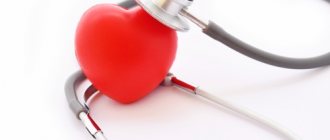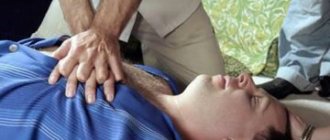What is heart failure?
Heart failure is a pathological condition caused by the inability of the heart to provide adequate blood supply to organs and tissues during exercise, and in more severe cases, at rest. In heart failure, the heart is not able to effectively pump blood, and therefore the circulation of oxygen and nutrients in the body is disrupted, which leads to stagnation of blood in the tissues, swelling in the legs, in severe cases in the abdominal cavity (ascites), in the lungs . Heart failure is not an independent disease; it is considered a complication of other diseases and conditions. In the United States, heart failure affects about 1% of the population (2.5 million people). Heart failure accounts for one in 20 hospitalizations and is more fatal than many types of cancer. The incidence of heart failure increases with age—10% of the population over 75 years of age in the United States.
3. How to prevent worsening of the condition in heart failure?
To prevent congestive heart failure from progressing, it is important to monitor your health very closely. Do not violate the recommended medication regimen. And you need to regularly visit your doctor to make sure that the disease is not developing. Fluid retention in the body is one of the symptoms of heart failure and is a reason to immediately consult a doctor. Dizziness, weakness, shortness of breath can also be signs of heart failure, and if these symptoms reappear during treatment, do not delay a visit to a specialist.
About our clinic Chistye Prudy metro station Medintercom page!
Symptoms of heart failure
When the heart does not work efficiently, people notice that they expend more energy than before when doing the same work, they get tired faster, and experience rapid breathing (shortness of breath). This is due to the fact that the tissues do not receive enough oxygen. Arrhythmias, dizziness, darkening of the eyes, fainting, swelling of the neck veins, pale skin, swelling in the ankle area - which is called edema and is associated with the accumulation of excess fluid in the tissues - may occur. The skin becomes “loose” and if you press on it with your finger, the resulting “dent” or hole remains for quite a long time. As heart failure progresses, the level of edema observed becomes higher; tissue pastiness can be noticed even in the abdomen and lower back.
These symptoms tend to develop gradually and usually go unnoticed for a long time. Symptoms of heart failure increase, the general condition slowly deteriorates and increasingly affects the person's ability to perform normal work. There are often periods when a person's condition remains fairly stable, interspersed at times with episodes of acute worsening of symptoms. In the later stages, complaints arise not only during exercise, but also at rest, and the ability to work is completely lost. Due to insufficient blood supply, all organs and systems of the body suffer to one degree or another. Abnormal heart rhythms are a bad sign of heart failure—about half of people with heart failure die suddenly as a result of fatal arrhythmias.
The main complaints of patients with the development of heart failure:
- Swelling of the soft tissues of the feet and legs are the initial symptoms of right ventricular heart failure, uniformly affecting both legs, occurring in the late afternoon and disappearing by the morning. With the development of insufficiency, the swelling becomes dense and does not go away completely, ordinary shoes become tight, patients feel comfortable only in house slippers.
- Ascites is an accumulation of fluid in the abdominal cavity.
- Enlargement of the liver - discomfort (unpleasant sensations, heaviness) and pain in the right hypochondrium.
- Fast fatiguability.
- Dyspnea is the main, often the first symptom of chronic left ventricular failure. As heart failure progresses, shortness of breath may occur during normal conversation, and sometimes even at complete rest.
- Paroxysmal cough after performing intense exercise.
- Rapid heartbeat (sinus tachycardia) is a feeling of “fluttering” in the chest that occurs during any physical activity.
2.What surgical procedures are used to treat heart failure?
The surgery helps heart failure patients prevent further damage to the heart and improve its function. During treatment the following may be carried out:
- Bypass surgery
. Bypass surgery is the most common surgery performed to treat heart failure. This procedure helps bypass a blocked heart artery and create an additional pathway for blood flow to the heart. - Implantation of a left ventricular assist device (LVAD)
. This device helps the heart pump blood. Sometimes LVAD implantation is a temporary measure until the patient can undergo a heart transplant. And if necessary, the device will work for several years before heart transplantation. It also happens that for some reason a heart transplant is impossible for a particular patient. And then implantation of a circulatory support device may become the main method of treatment. It is worth noting that this practice of using LVADs is becoming increasingly popular, because the devices themselves are constantly being improved. It is interesting that sometimes after a certain period of life with an implant, the heart is restored (it seems to get the opportunity to rest, and continues to work with new strength). But in most cases, congestive heart failure is still a serious chronic disease. - Heart valve surgery.
As heart failure progresses, the heart valves, which are needed to direct blood flow through the heart to all organs, become less able to function. This can cause blood to flow in the opposite direction. During surgery, the fit of the valves can be restored or even replaced. - Surgical treatment of the consequences of a heart attack.
If a heart attack occurs in the left ventricle, a scar forms in this place. The scar area is very thin and can bulge with every heartbeat (aneurysm). A heart surgeon may remove an area of dead heart tissue or an aneurysm. - Heart transplant
. Heart transplantation to treat heart failure is used only when the disease is very severe and other treatments have not helped.
Visit our Cardiology page
Diagnosis of heart failure
Electrocardiography (ECG) helps doctors identify signs of hypertrophy and insufficient blood supply (ischemia) of the myocardium, as well as various arrhythmias.
An ECG with a load - a special modification of a bicycle (bicycle ergometry) or a “treadmill” (treadmill) - provides information about the reserve capabilities of the pumping function of the heart.
Echocardiography (EchoCG). Using this method, you can not only determine the cause of heart failure, but also evaluate the contractile function of the ventricles of the heart.
X-ray examination of the chest organs in heart failure reveals stagnation of blood in the pulmonary circulation and an increase in the size of the heart cavities (cardiomegaly).
Radioisotope methods for studying the heart, in particular radioisotope ventriculography, make it possible to assess with high accuracy the contractile function of the ventricles of the heart and the volume of blood they contain in patients with heart failure. These methods are based on the administration and subsequent distribution of radioisotope drugs in the body.
Positron emission tomography – PET – allows using a special radioactive “tag” to identify areas of viable myocardium in patients with heart failure.
Treatment of chronic heart failure. Decompensation of CHF.
First of all, patients are advised to follow an appropriate diet and limit physical activity. You should completely avoid fast carbohydrates, hydrogenated fats, in particular those of animal origin, and also carefully monitor your salt intake. It is also necessary to immediately stop smoking and drinking alcohol.
All methods of therapeutic treatment of chronic heart failure consist of a set of measures that are aimed at creating the necessary conditions in everyday life that contribute to a rapid reduction in the load on the cardiovascular system, as well as the use of medications designed to help the myocardium work and influence impaired water processes. salt metabolism. The purpose of the volume of treatment measures is related to the stage of development of the disease itself.
Treatment of chronic heart failure is long-term. It includes:
- Drug therapy aimed at combating the symptoms of the underlying disease and eliminating the causes contributing to its development.
- A rational regime, including restriction of work activity according to the forms and stages of the disease. This does not mean that the patient must remain in bed all the time. He can move around the room, and exercise therapy is recommended.
- Diet therapy. It is necessary to monitor the caloric content of food. It must comply with the patient’s prescribed regimen. For obese people, the calorie content of food is reduced by 30%. On the contrary, patients with malnutrition are prescribed enhanced nutrition. If necessary, fasting days are carried out.
- Cardiotonic therapy.
- Treatment with diuretics aimed at restoring water-salt and acid-base balance.
Patients with the first stage are fully able to work; in the second stage, there is limited ability to work or it is completely lost. But in the third stage, patients with chronic heart failure require constant care.
Drug treatment
Drug treatment of chronic heart failure is aimed at increasing contraction functions and ridding the body of excess fluid. Depending on the stage and severity of symptoms for heart failure, the following groups of drugs are prescribed:
- Vasodilators and ACE inhibitors - angiotensin-converting enzyme (enalapril, lisinopril, perindopril, ramipril) - reduce vascular tone, dilate veins and arteries, thereby reducing vascular resistance during heart contractions and helping to increase cardiac output;
- Cardiac glycosides (digoxin, etc.) – increase myocardial contractility, increase its pumping function and diuresis, and promote satisfactory exercise tolerance;
- Nitrates (nitroglycerin, dilasid, etc.) - improve blood flow to the ventricles, increase cardiac output, dilate the coronary arteries;
- Diuretics (furosemide, spironolactone, torsemide) – reduce the retention of excess fluid in the body;
- B-blockers (carvedilol, bisoprolol) - reduce heart rate, improve blood flow to the heart, increase cardiac output;
- Drugs that improve myocardial metabolism (B vitamins, mildronate, potassium preparations);
- Anticoagulants (aspirin, warfarin, rivaroxaban) – prevent thrombus formation in blood vessels.
Monotherapy in the treatment of CHF is rarely used, and only ACE inhibitors can be used in this capacity in the initial stages of CHF.
Triple therapy (ACE inhibitor + diuretic + glycoside) was the standard in the treatment of CHF in the 80s, and now remains an effective regimen in the treatment of CHF, however, for patients with sinus rhythm, it is recommended to replace the glycoside with a beta-blocker. The gold standard from the early 90s to the present is a combination of four drugs - ACE inhibitor + diuretic + glycoside + beta-blocker.
Decompensation of CHF
The main symptoms that require immediate medical attention Heart failure is a very dangerous condition in which the heart is not able to sufficiently perform its functions. As a result, the organs and all tissues of the body do not receive the required amount of blood, which supplies oxygen and nutrients. This disease has several stages of development, the most dangerous, the third, is decompensation.
Heart failure in the decompensation stage often leads to death. In this case, the heart fails to cope with its task not only during physical or emotional stress, but even if the person is in a calm state. This form is irreversible, and therefore so dangerous.
Decompensated heart failure is characterized by:
- Enlargement of the myocardium, or rather, its stretching and thinning.
- Fluid retention in the body.
- Rapid decrease in cardiac output.
- Swelling of the myocardium.
The chronic form of decompensation is a long-term process, that is, this pathology develops over the course of years, and at the same time progresses. Its peculiarity lies in the fact that due to any damage to the organ (necrosis, inflammation, dysplasia), the myocardial cells change. This affects its functioning. But the cells that are not yet affected do the work of compensating for the dysfunction of the affected myocytes. Then decompensation occurs, and the heart is not able to pump blood in the required quantity.
Symptoms
Pathology exhibits quite a lot of symptoms. There are no specific signs by which the disease can be accurately diagnosed.
Decompensated heart failure is a consequence of other heart diseases, so the clinical picture is quite varied, as some symptoms overlap with others.
The main symptoms of decompensated heart failure:
- Dyspnea. It manifests itself under light loads, but if there is no appropriate treatment, the pathology progresses and is disturbing, even if the person is in a calm state. This occurs due to congestion in the lungs.
- Swelling of the legs and arms. They are explained by impaired outflow of fluid from the body. In this case, the heart muscle is also affected.
- Dry cough.
- Pain or discomfort in the right hypochondrium.
- Ascites is dropsy in the abdominal cavity. At the same time, the stomach and weight of a person increase significantly.
- General weakness, feeling of overwork.
- Cold feet and hands.
- Small amount of urine, rare urge to urinate.
Prevention and prognosis
To prevent heart failure, you need proper nutrition, sufficient physical activity, and giving up bad habits. All diseases of the cardiovascular system must be promptly identified and treated.
The prognosis in the absence of treatment for CHF is unfavorable, since most heart diseases lead to its wear and tear and the development of severe complications. When carrying out drug and/or cardiac surgery, the prognosis is favorable, because the progression of the insufficiency slows down or a radical cure for the underlying disease occurs.
Treatment of heart failure
If acute heart failure develops, hospitalization is necessary. The main emphasis in treatment is both on eliminating the causes of heart failure (stress, excessive consumption of table salt, alcohol abuse, smoking, high blood pressure, as well as taking medications that promote fluid retention in the body, etc.), and on correcting it manifestations. Limiting physical activity. Physical activity is acceptable and desirable, but it should not cause significant fatigue or discomfort. The diet should be low in salt, with plenty of fruits and vegetables. It is very important to achieve a reduction in excess weight, as it creates a significant additional burden on a diseased heart.
Currently, the following medications are used to treat heart failure:
- increased myocardial contractility;
- decreased vascular tone;
- reducing fluid retention in the body;
- elimination of sinus tachycardia;
- prevention of thrombus formation in the cavities of the heart.
If medications used to treat chronic heart failure are ineffective, surgical treatment may be recommended - cardiomyoplasty, cardiac pacing. Typically, medical monitoring of patients with heart failure is necessary throughout their lives.
Cardiovascular drugs
Cardiovascular drugs are medications used to treat heart failure and disorders of vascular tone. These include cardiac glycosides, vasodilators (vasodilators) and vasoconstrictors (vasoconstrictors). Most cardiac glycosides are close in structure and action to digitalis glycosides. The main differences are in the speed, duration of action, ability to accumulate, and side effects. Under the influence of these drugs, strength increases and heart rate decreases, and tissue metabolism of the heart muscle improves. They are used (medical supervision is required!) for heart failure and cardiac arrhythmias (tachyarrhythmic form of atrial fibrillation, supraventricular form of paroxysmal tachycardia). Of greatest practical importance are various types of foxglove (leaf powder, infusion, extract), glycosides isolated from them (digitoxin, digoxin, etc.) and preparations containing the sum of glycosides (for example, lantoside), preparations of strophanthus, spring adonis (for example, adonizide ), lily of the valley (korglykon, etc.), jaundice (erizimin), etc.
Vasodilators relax the smooth muscles of the coronary and peripheral arteries and reduce vascular spasms. For example, stopping an attack of angina pectoris is achieved by using fast-acting vasodilators (nitroglycerin, amyl nitrite). In case of chronic coronary insufficiency, long-acting vasodilators are used to prevent attacks - erinitis, sustak, etc., as well as aminophylline, papaverine. A number of drugs, for example carbochromene (intensain), not only increase coronary blood flow, but also improve metabolic processes in the heart, reduce myocardial oxygen demand, and enhance collateral circulation. Anaprilin (Inderal), a beta-blocker, improves metabolic processes in the heart, while simultaneously reducing myocardial contractile activity. Pyridinol carbamate (anginine) improves microcirculation, etc. Drug therapy for lesions of peripheral arteries includes the use of vasodilators, substances that stimulate the formation of collaterals, improving microcirculation. For vascular insufficiency accompanied by hypotension, drugs that stimulate the vasomotor center (cordiamin, corazol, camphor) are prescribed. In cases of acute vascular insufficiency (Collapse), fast-acting vasoconstrictors (norepinephrine, mesaton, angiotensin amide, etc.) are used.








